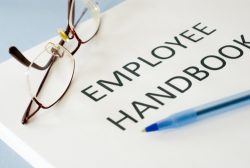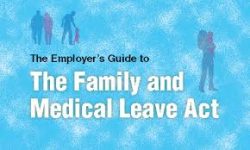07.13.16
What Good is an Employee Handbook, Anyway?
HR NEWS
What Good is an Employee Handbook, Anyway?

A Google search for “most boring book in the world” results in a wide variety of titles from Moby Dick to the Twilight series. But a quick survey of folks around the office might show a very different consensus: your Employee Handbook. It’s understandable to some extent – dry, legalese policies…multiple appearances of the phrase “up to and including termination”…and no vampires (right?). Even worse, an outdated handbook or supervisors who don’t implement its policies can expose your organization to significant legal risk.
So why bother? Is it really worth your valuable time and money to create an Employee Handbook that no one wants to read? You bet it is.
- Both federal and state laws require employers to clearly inform employees of their rights on a variety of topics including leaves of absence, paydays, and reporting workplace concerns. A well-written handbook demonstrates your compliance with the law and builds trust with your staff. It also allows you to clarify employees’ responsibilities such as reasonable notice for time off and medical certification for disability accommodations.
- Sound, compliant policies can provide a starting point for defending legal claims. When faced with an accusation of missed rest periods or discouraging safety suggestions, handbook language such as, “Employees are encouraged to take rest periods…” or “Our company welcomes all safety-related concerns and complaints” can establish your company’s general approach to the topic in question.
- Your handbook should provide a valuable road map for supervisors to answer employee questions and address performance concerns. Consistent application of performance standards and behavior expectations bolsters supervisor confidence, strengthens employee trust in your decision-making, and reduces your risk of discrimination claims. By including specific policy language in your verbal or written warnings, you also add credibility to your request for improvement.
It’s important to note that an outdated handbook collecting dust on a shelf can actually do more harm than good. If managers are not familiar with what the policies say, or if company practices have changed over time, you may be losing the benefits described above. Employees who never before cared to read the handbook will be quick to point out your failure to abide by its policies when they have a complaint.
Want to keep reading? Become an HR Business Partner and receive our monthly newsletter by email.
06.23.16
Don’t Get Burned by Summertime Events
HR Bulletin
Don’t Get Burned by Summertime Events

The summer season is upon us, and many employers look forward to planning events such as barbeques, baseball games, and water park trips. These outings provide excellent opportunities to reward employees, socialize with families, and enjoy time away from the normal pressures of the office…but as a manager or HR professional, this is not the time to let down your guard.
Employer Liability
Employees and managers alike tend to think that “what happens away from the office, stays away from the office.” But under the doctrine of respondeat superior, an employer may be held liable for acts committed by employees within the course and scope of their employment, whether at the workplace or not. Furthermore, the employee does not need to be engaged in his/her actual job responsibilities to be deemed “under the control of the employer.” Participation or attendance at a summer party that is sponsored or endorsed by the employer may create this liability. Liability is strengthened if the event is mandatory or if the employer may be seen as benefiting from the event, through awards presentations or discussion of company programs or goals.
Sexual Harassment
Summer events are perfect environments for employees to relax from the formal dress code of your office, but bathing suits or other revealing clothing can easily open the door to suggestive comments or behavior. A one-time incident at a summer picnic may be severe enough to create liability, or may be cited as part of a pervasive pattern of inappropriate conduct.
Remember than an employer may also be liable for harassing conduct by family members and event-site workers. So even if your employees are on their best behavior, you could be seen as responsible for the actions of third-parties if you knew or should have known, and failed to take corrective action.
Employee Injuries
Workers’ compensation typically does not cover injuries arising out of voluntary participation in off-duty events, but if a social event is considered to be work-related, workers’ compensation insurance may apply to injured employees. (California Labor Code section 3600).
Also, a third-party, such as an employee’s guest, could sue the employer for an injury sustained at a work party, whether or not employees were in the course and scope of employment.
You may reduce this risk by avoiding high-risk activities such as water skiing, and ensuring that only responsible individuals operate barbeque grills and other cooking equipment. Keep a close eye on bounce houses, obstacle courses and races, and any water activities.
Alcohol Consumption
The risks for harassment claims and injuries are heightened when employees consume alcohol at social events. In a 2004 legal claim involving liability for injuries caused by drunk driving after a company party, the court stated, “Existing California case law clearly establishes that an employer may be found liable for its employee’s torts as long as the proximate cause of the injury occurred within the scope of employment. It is irrelevant that foreseeable effects of the employer’s negligent conduct occurred at a time the employee was no longer acting within the scope of his or her employment.”
Social Media
Ever-present “selfies” and social media posts increase the likelihood that images and recordings of less-than-professional behavior will be shared outside of the company, damaging company image and employee credibility. There are several social media pages dedicated to “Embarrassing Party Photos” and “Party Fails,” not to mention employees’ personal accounts.
HR Best Practices
So what’s a good HR Manager to do? You can help to ensure that employee have a great time while protecting the interests of your company with the following steps:
- Clearly inform employees that events are voluntary.
- Minimize activities such as awards, goal-setting, or review of the year’s accomplishments. Save these discussions for workplace meetings.
- Remind employees and managers about appropriate conduct, anti-harassment policies, and social media policies.
- Shape your social media policy in advance and explain the expectations to all employees. Be prepared to address inappropriate social media posts.
- Consider no alcohol, a cash bar, or drink tickets to limit alcohol consumption.
- Make arrangements for sober transportation (taxi, Uber, designated drivers).
- Follow standard procedures if an employee is injured including providing the DWC-1 Form within one working day and notifying your workers’ compensation carrier of the incident.
- Promptly investigate any complaints of harassment or inappropriate behavior.
- Enlist the help of other managers to watch for inappropriate behavior and excessive drinking, and take necessary steps. (Yes, HR does need to be the “police” sometimes for the protection of all involved.)
Review Your Heat Illness Procedures
It may not be officially summer on the calendar, but the Valley heat has certainly arrived. If you have any employees working outdoors, be sure they are updated on your Heat Illness Prevention procedures including cool-down recovery periods in the shade, drinking cool water on a regular basis, and responding to signs and symptoms of heat illness. When temperatures exceed 95 degrees, supervisors have a more proactive responsibility to monitor employees and encourage them to drink water.
Want to read the full newsletter? Become an HR Business Partner and receive our monthly updates by email.
As an HR Business Partner, you receive:
- Unlimited phone consultation by certified HR consultants Monday through Friday, 8 a.m. – 5:30 p.m.
- Free monthly legal seminars for designated representative
- Breaking employment news & best practices
- Discounted project rates
- Peace of mind
05.23.16
Updated Requirements for Anti-Discrimination and Harassment
HR Bulletin
Updated Requirements for Anti-Discrimination and Harassment

Significant changes to California’s Fair Employment and Housing Act (FEHA) become effective on April 1st. The updates include:
- Specific requirements for harassment and discrimination training including content to address “abusive conduct” and recordkeeping requirements for e-learning sessions and webinars;
- Updated definitions relating to gender expression, gender identity and transgender employees; and
- An employer’s affirmative duty to take reasonable steps to prevent and promptly correct discriminatory and harassing conduct.
One of the biggest changes to FEHA is the express requirement for employers to develop a written harassment, discrimination and retaliation prevention policy that must address eight specific topics including all protected categories covered by the Act, a compliant process that ensures confidentiality to the extent possible, impartial and timely investigations, a guarantee of no retaliation, and appropriate remedial actions and resolutions. The policy may be distributed to employees in print or via e-mail, and should include an acknowledgement return form. FEHA also requires that the policy be translated into any language that is spoken by at least 10% of an employer’s workforce.
You may have received notices from law offices or your payroll service warning you of the impending changes. If your Employee Handbook was prepared by Sierra HR Partners or Fishman, Larsen & Callister you can rest assured that we are on top of these updates and will be providing new policy language in a timely manner. (If your handbook has not been updated through 2016, please contact us so we can be sure it contains the most recent information.) If you have other questions about how the FEHA requirements may affect your business, please contact us.
Form I-9 Expiration Date
You may have noticed that your Form I-9 has an expiration date of March 31, 2016. The U.S. Citizenship and Immigration Service (USCIS) has directed that employers continue to use the existing form until its proposed changes are approved by the Office of Management and Budget. Sierra HR Partners will keep you updated when a revised Form I-9 is released.
Sierra HR Partners can provide Anti-Harassment and Discrimination Prevention training for you employees. Our program, developed with lawyers, meets all AB 1825 requirements, including AB 2053’s amendment covering abusive conduct/bullying, in an interactive forum. Click here for more information, or give us a call to discuss booking a session.
05.09.16
Workplace Whirlwind
HR Bulletin
Workplace Whirlwind: Minimum Wage Increase and Paid Family Leave Changes
The employment landscape is rapidly changing! Sierra HR Partners is here to ensure you stay informed. This newsletter includes a few recent legislative developments that may impact your workforce.
CA Minimum Wage Increase

Starting in January 2017 California’s minimum wage will begin increasing to $15/hr. by 2022 as reflected in the following table. Employers with 25 or fewer employees will have one additional year to reach the $15/hr. mark with increases beginning January 2018. You should also note that an increase in minimum wage translates to a new minimum salary requirement for exempt status.
|
Increase Date
|
New Rate |
New Salary Threshold
|
| January 1, 2017 |
$10.50 |
$43,680 |
| January 1, 2018 |
$11.00 |
$45,760 |
| January 1, 2019 |
$12.00 |
$49,920 |
| January 1, 2020 |
$13.00 |
$54,080 |
| January 1, 2021 |
$14.00 |
$58,240 |
| January 1, 2022 |
$15.00 |
$62,400 |
Paid Family Leave Changes
Effective January 2017 employees will no longer need to serve a seven-day, non-payable waiting period before receiving partial wage replacement benefits. Plus, the wage replacement rate will increase from current 55% to up to 70% dependent upon earnings.
Paid Family Leave is part of California’s temporary disability insurance program administered by EDD. It provides employees with up to six weeks of partial wage replacement benefits when on an approved leave of absence to bond with a new child or to care for a family member with a serious medical condition.
Updated Policy Prohibiting Unlawful Discrimination and Harassment
As a follow-up to last month’s newsletter discussing the significant changes to California’s Fair Employment and Housing Act (FEHA) regulations on 4/1, Sierra HR Partners now has an updated standalone policy for your use. Contact one of our consultants for details.
Did you know?
The Department of Labor (DOL) recently published its first FMLA guide for employers. This publication follows an employee guide published a few years ago that is quite informative. According to the DOL the employer guide “provides essential information about the FMLA, including information about employers’ obligations under the law and the options available to employers in administering leave under the FMLA.”

The Family and Medical Leave Act (FMLA) is a federal law that provides eligible employees of covered employers with unpaid, job-protected leave for specified family and medical reasons. Please note that if your employee’s leave also runs concurrently with CFRA (California’s medical leave) then you will need to also reference those state-specific regulations.
Sierra HR Partners is available to answer your questions on regulatory leaves of absences.
03.15.16
Protecting Employee Data
HR Bulletin
Protecting Employee Data

As an employer, are you taking the necessary steps to keep your employee information confidential and secure? In today’s information age, data breaches are a too common occurrence and lead to a multitude of problems. The rise in identify theft has led to laws imposing restrictions on the use and disclosure of employee social security numbers, and company obligations for responding to security breaches of electronically stored information such as payroll records and personally identifiable information.
California civil code defines personal information as:
(A) An individual’s first name or first initial and his or her last name in combination with any one or more of the following data elements, when either the name or the data elements are not encrypted or redacted:
(i) Social security number.
(ii) Driver’s license number or California identification card number.
(iii) Account number, credit or debit card number, in combination with any required security code, access code, or password that would permit access to an individual’s financial account.
(iv) Medical information.
(v) Health insurance information.

________________________________________
The law requires businesses to promptly notify affected individuals of a security breach in the most expedient time possible and without unreasonable delay. The written notification should include at a minimum: 1) what happened, 2) information involved, 3) what action you are taking, and, 4) what the employee can do. You may contact your legal counsel or refer to the civil code for additional information.
A few recommended steps to safeguard employee data:
• Partner with your trusted IT provider
• Consult with legal counsel or Sierra HR Partners on best practices for collecting, storing and retaining employee data
• Restrict access to employee records
If one of your employees is a victim of identify theft, encourage him or her to file a police report, and to contact all creditors and reporting agencies.
DID YOU KNOW?
California’s Department of Fair Employment and Housing has a few amendments that impact employee notifications? One recent update is guidance on Transgender Rights in The Workplace. We will keep you apprised of additional updated notices as they are published.Click here for a full list of DFEH notices and brochures.







